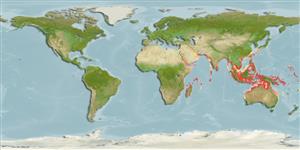Environment: milieu / climate zone / depth range / distribution range
Écologie
marin; eau douce; saumâtre démersal; amphidrome (Ref. 51243). Tropical; 27°N - 19°S, 72°E - 177°W
Indo-West Pacific: west and south coasts of India and off Sri Lanka eastward along the coasts of Bangladesh and Myanmar, through the Indo-Australian Archipelago and the Philippines as far as Papua New Guinea.
Taille / Poids / Âge
Maturity: Lm ? range ? - ? cm
Max length : 111 cm TL mâle / non sexé; (Ref. 127983); common length : 80.0 cm TL mâle / non sexé; (Ref. 3478)
Description synthétique
Clés d'identification | Morphologie | Morphométrie
A plain dusky-brown species with a black dorsal fin tip. Shows banded pattern at night. Distinguished from adult Plotosus lineatus by its long barbels on the nostrils that can reach pass the eyes.
Adults found mostly in estuaries and lagoons, and sometimes up rivers in nearly fresh waters. They occur in the lower parts of rivers in freshwater or brackish water and in coastal seas (Ref. 12693, 48635). It is reported to have an extended breeding season and likely spawns in brackish water, based on optimal sperm survival at 0.9 % salinity; produces relatively few large eggs, consistent with parental care and it is possible that male fish construct nests and guard their fry (Ref. 127983), Maximum length of 150 cm TL is without actual specimen (Ref. 3478). Juveniles may occur in dense aggregations (Ref. 9801). Feed on crustaceans, mollusks and fishes. Spines associated with anterior fins have potent venom. Marketed mostly fresh.
Life cycle and mating behavior
Maturité | Reproduction | Frai | Œufs | Fécondité | Larves
Gomon, J.R., 1984. Plotosidae. In W. Fischer and G. Bianchi (eds.) FAO species identification sheets for fishery purposes. Western Indian Ocean fishing area 51. Vol. 3. (Ref. 3478)
Statut dans la liste rouge de l'IUCN (Ref. 130435: Version 2024-1)
Utilisations par l'homme
Pêcheries: commercial
Outils
Articles particuliers
Télécharger en XML
Sources Internet
Estimates based on models
Preferred temperature (Ref.
123201): 25.1 - 29.1, mean 28.3 °C (based on 1244 cells).
Phylogenetic diversity index (Ref.
82804): PD
50 = 0.5020 [Uniqueness, from 0.5 = low to 2.0 = high].
Bayesian length-weight: a=0.00501 (0.00284 - 0.00885), b=3.01 (2.85 - 3.17), in cm total length, based on LWR estimates for this species & (Sub)family-body (Ref.
93245).
Niveau trophique (Ref.
69278): 3.8 ±0.4 se; based on diet studies.
Generation time: 3.9 ( na - na) years. Estimated as median ln(3)/K based on 1
growth studies.
Résilience (Ref.
120179): Milieu, temps minimum de doublement de population : 1,4 à 4,4 années (Preliminary K or Fecundity.).
Prior r = 0.66, 95% CL = 0.44 - 0.99, Based on 1 full stock assessment.
Fishing Vulnerability (Ref.
59153): Moderate vulnerability (43 of 100).
Nutrients (Ref.
124155): Calcium = 63.2 [34.5, 108.6] mg/100g; Iron = 0.78 [0.49, 1.27] mg/100g; Protein = 16.9 [14.7, 19.1] %; Omega3 = 0.147 [0.082, 0.262] g/100g; Selenium = 81.8 [43.4, 163.8] μg/100g; VitaminA = 11.2 [5.1, 25.6] μg/100g; Zinc = 0.934 [0.684, 1.292] mg/100g (wet weight);
